Impact of Exchange Rate and Fuel on Qantas Cost Structure Analysis
VerifiedAdded on 2020/05/28
|18
|4239
|203
Report
AI Summary
This applied business research report examines the cost structure of Qantas, a leading Australian airline, focusing on the impact of product costs (particularly aircraft prices) and exchange rates on its profitability. The study investigates the current challenges Qantas faces in managing its cost structure, including the influence of currency fluctuations on imported aircraft and fuel expenses. The research poses several hypotheses and research questions to understand the risk factors associated with exchange rate fluctuations, the impact of aircraft and fuel prices on the cost structure, and the strategies Qantas employs to mitigate these risks. The report includes a literature review on cost structures, airline cost structures, and the impact of direct operating costs, fuel costs, aircraft costs, and currency exchange rates. The research identifies gaps in the existing literature and aims to connect these interrelated issues faced by airline organizations. The report also considers ethical considerations and provides a detailed analysis of the various factors affecting Qantas's financial performance and offers recommendations for improving its competitive advantage.
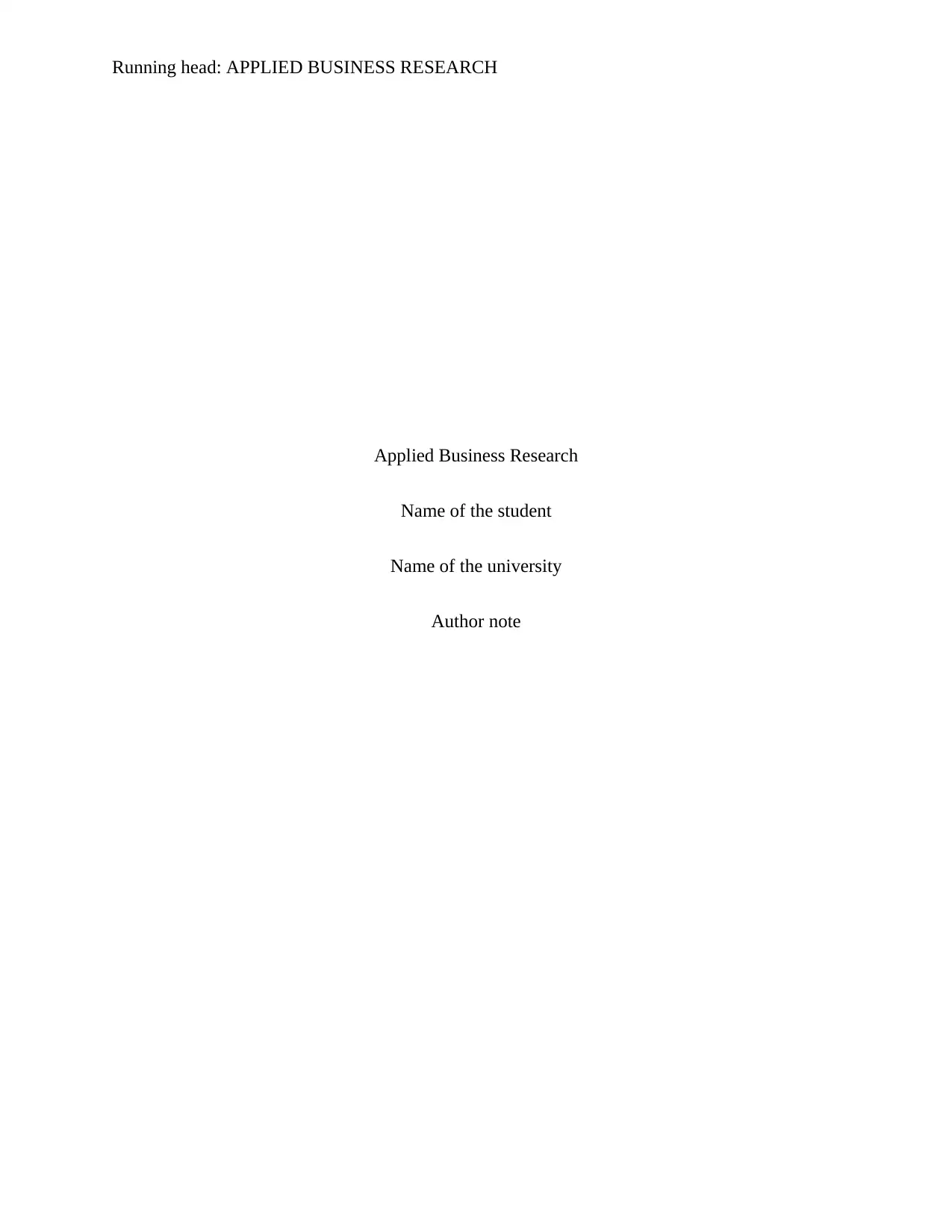
Running head: APPLIED BUSINESS RESEARCH
Applied Business Research
Name of the student
Name of the university
Author note
Applied Business Research
Name of the student
Name of the university
Author note
Paraphrase This Document
Need a fresh take? Get an instant paraphrase of this document with our AI Paraphraser
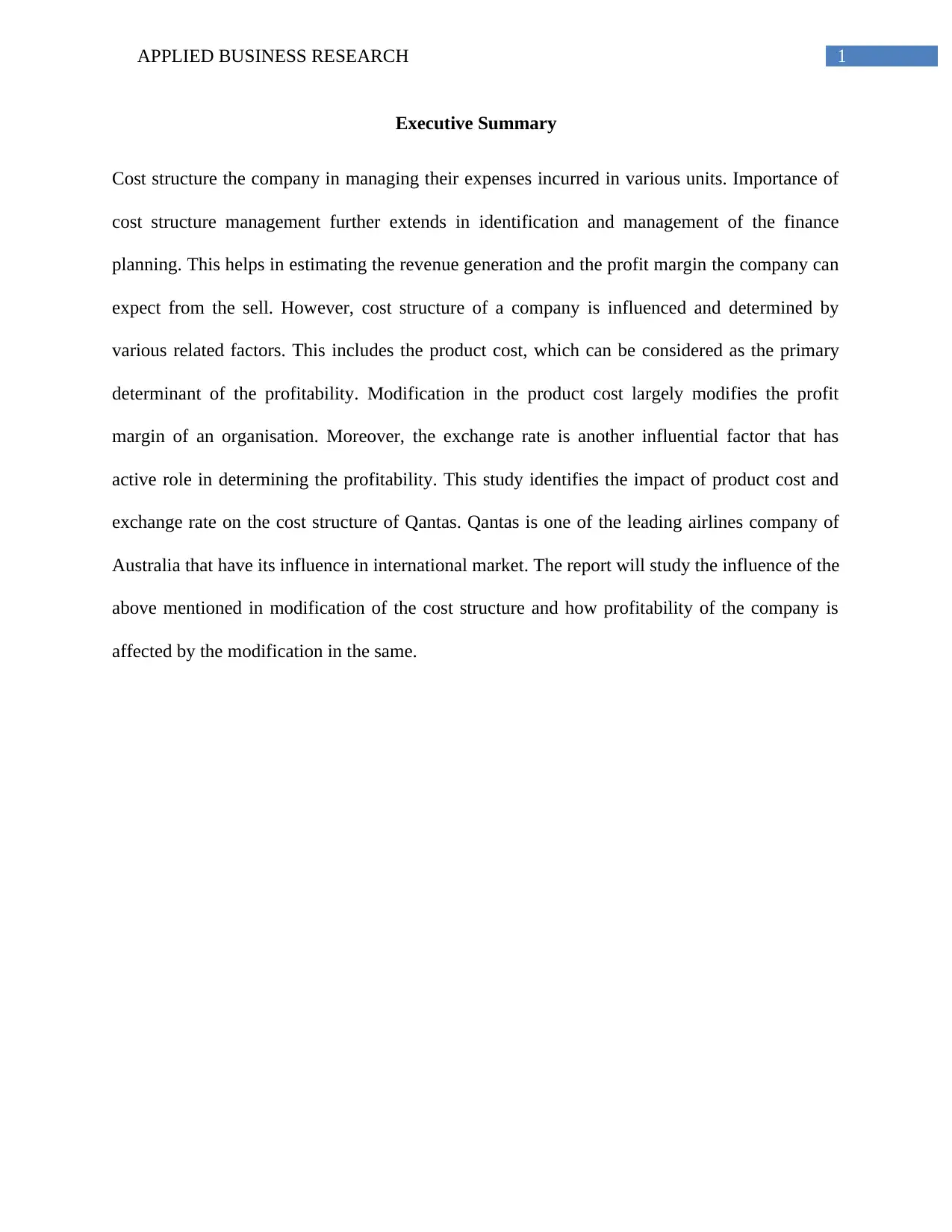
1APPLIED BUSINESS RESEARCH
Executive Summary
Cost structure the company in managing their expenses incurred in various units. Importance of
cost structure management further extends in identification and management of the finance
planning. This helps in estimating the revenue generation and the profit margin the company can
expect from the sell. However, cost structure of a company is influenced and determined by
various related factors. This includes the product cost, which can be considered as the primary
determinant of the profitability. Modification in the product cost largely modifies the profit
margin of an organisation. Moreover, the exchange rate is another influential factor that has
active role in determining the profitability. This study identifies the impact of product cost and
exchange rate on the cost structure of Qantas. Qantas is one of the leading airlines company of
Australia that have its influence in international market. The report will study the influence of the
above mentioned in modification of the cost structure and how profitability of the company is
affected by the modification in the same.
Executive Summary
Cost structure the company in managing their expenses incurred in various units. Importance of
cost structure management further extends in identification and management of the finance
planning. This helps in estimating the revenue generation and the profit margin the company can
expect from the sell. However, cost structure of a company is influenced and determined by
various related factors. This includes the product cost, which can be considered as the primary
determinant of the profitability. Modification in the product cost largely modifies the profit
margin of an organisation. Moreover, the exchange rate is another influential factor that has
active role in determining the profitability. This study identifies the impact of product cost and
exchange rate on the cost structure of Qantas. Qantas is one of the leading airlines company of
Australia that have its influence in international market. The report will study the influence of the
above mentioned in modification of the cost structure and how profitability of the company is
affected by the modification in the same.
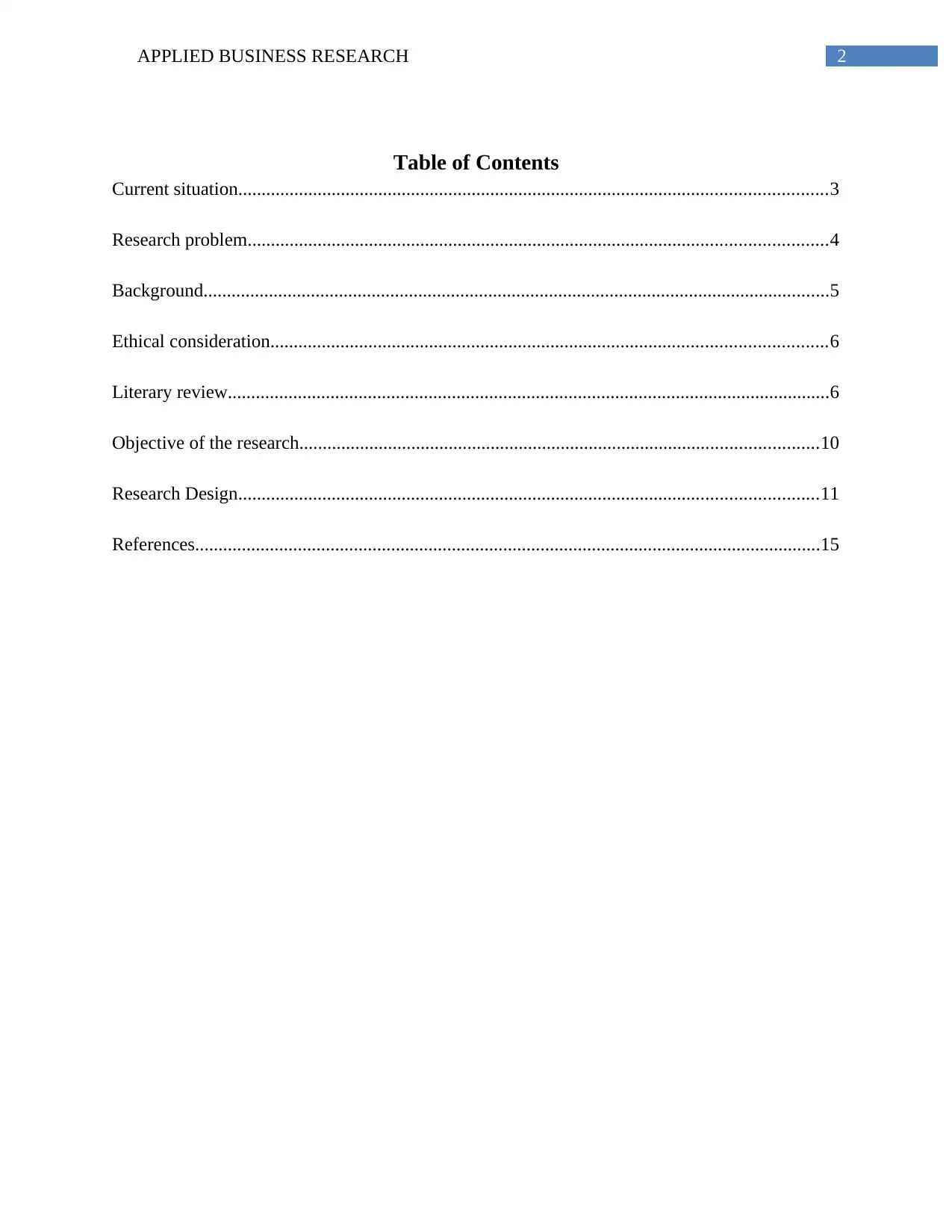
2APPLIED BUSINESS RESEARCH
Table of Contents
Current situation..............................................................................................................................3
Research problem............................................................................................................................4
Background......................................................................................................................................5
Ethical consideration.......................................................................................................................6
Literary review.................................................................................................................................6
Objective of the research...............................................................................................................10
Research Design............................................................................................................................11
References......................................................................................................................................15
Table of Contents
Current situation..............................................................................................................................3
Research problem............................................................................................................................4
Background......................................................................................................................................5
Ethical consideration.......................................................................................................................6
Literary review.................................................................................................................................6
Objective of the research...............................................................................................................10
Research Design............................................................................................................................11
References......................................................................................................................................15
⊘ This is a preview!⊘
Do you want full access?
Subscribe today to unlock all pages.

Trusted by 1+ million students worldwide
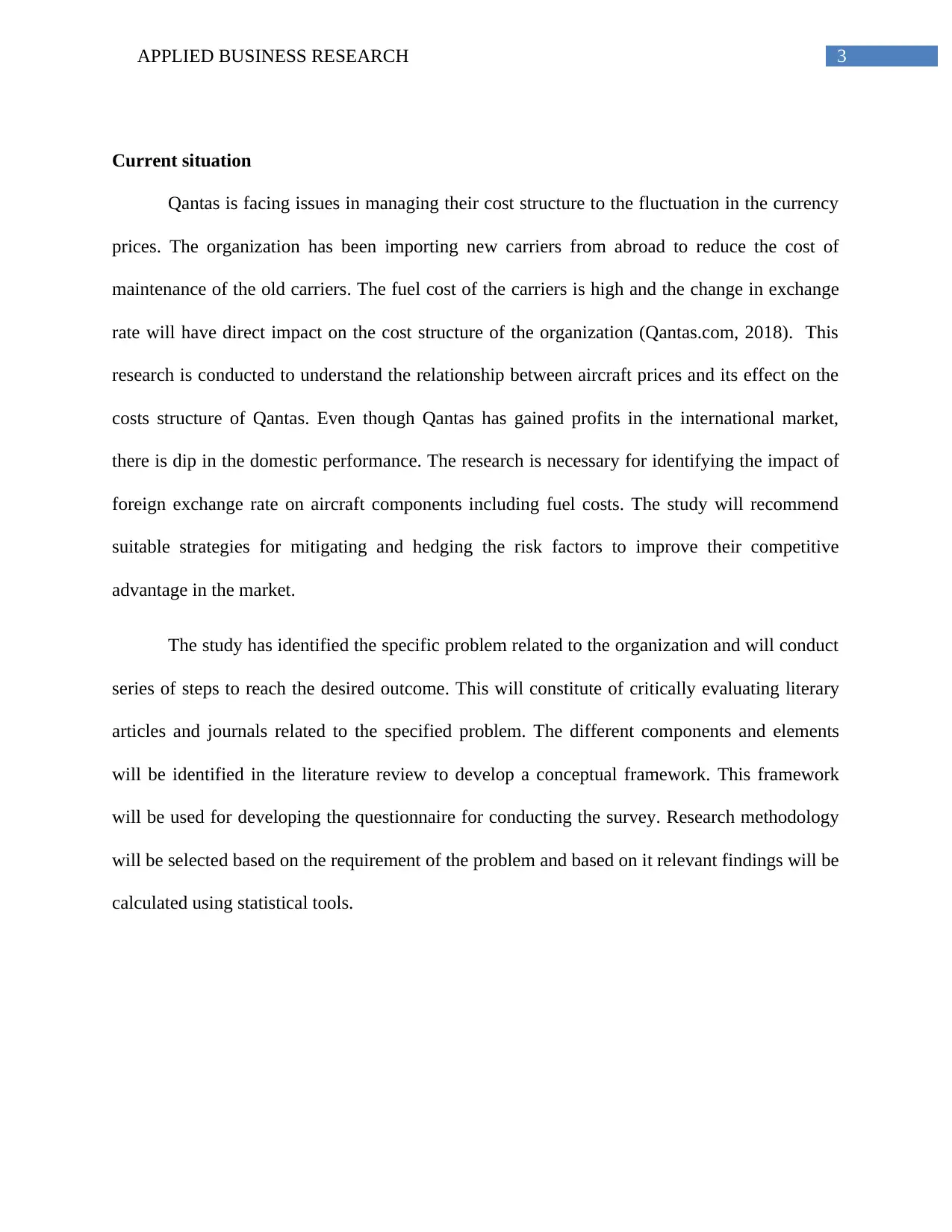
3APPLIED BUSINESS RESEARCH
Current situation
Qantas is facing issues in managing their cost structure to the fluctuation in the currency
prices. The organization has been importing new carriers from abroad to reduce the cost of
maintenance of the old carriers. The fuel cost of the carriers is high and the change in exchange
rate will have direct impact on the cost structure of the organization (Qantas.com, 2018). This
research is conducted to understand the relationship between aircraft prices and its effect on the
costs structure of Qantas. Even though Qantas has gained profits in the international market,
there is dip in the domestic performance. The research is necessary for identifying the impact of
foreign exchange rate on aircraft components including fuel costs. The study will recommend
suitable strategies for mitigating and hedging the risk factors to improve their competitive
advantage in the market.
The study has identified the specific problem related to the organization and will conduct
series of steps to reach the desired outcome. This will constitute of critically evaluating literary
articles and journals related to the specified problem. The different components and elements
will be identified in the literature review to develop a conceptual framework. This framework
will be used for developing the questionnaire for conducting the survey. Research methodology
will be selected based on the requirement of the problem and based on it relevant findings will be
calculated using statistical tools.
Current situation
Qantas is facing issues in managing their cost structure to the fluctuation in the currency
prices. The organization has been importing new carriers from abroad to reduce the cost of
maintenance of the old carriers. The fuel cost of the carriers is high and the change in exchange
rate will have direct impact on the cost structure of the organization (Qantas.com, 2018). This
research is conducted to understand the relationship between aircraft prices and its effect on the
costs structure of Qantas. Even though Qantas has gained profits in the international market,
there is dip in the domestic performance. The research is necessary for identifying the impact of
foreign exchange rate on aircraft components including fuel costs. The study will recommend
suitable strategies for mitigating and hedging the risk factors to improve their competitive
advantage in the market.
The study has identified the specific problem related to the organization and will conduct
series of steps to reach the desired outcome. This will constitute of critically evaluating literary
articles and journals related to the specified problem. The different components and elements
will be identified in the literature review to develop a conceptual framework. This framework
will be used for developing the questionnaire for conducting the survey. Research methodology
will be selected based on the requirement of the problem and based on it relevant findings will be
calculated using statistical tools.
Paraphrase This Document
Need a fresh take? Get an instant paraphrase of this document with our AI Paraphraser
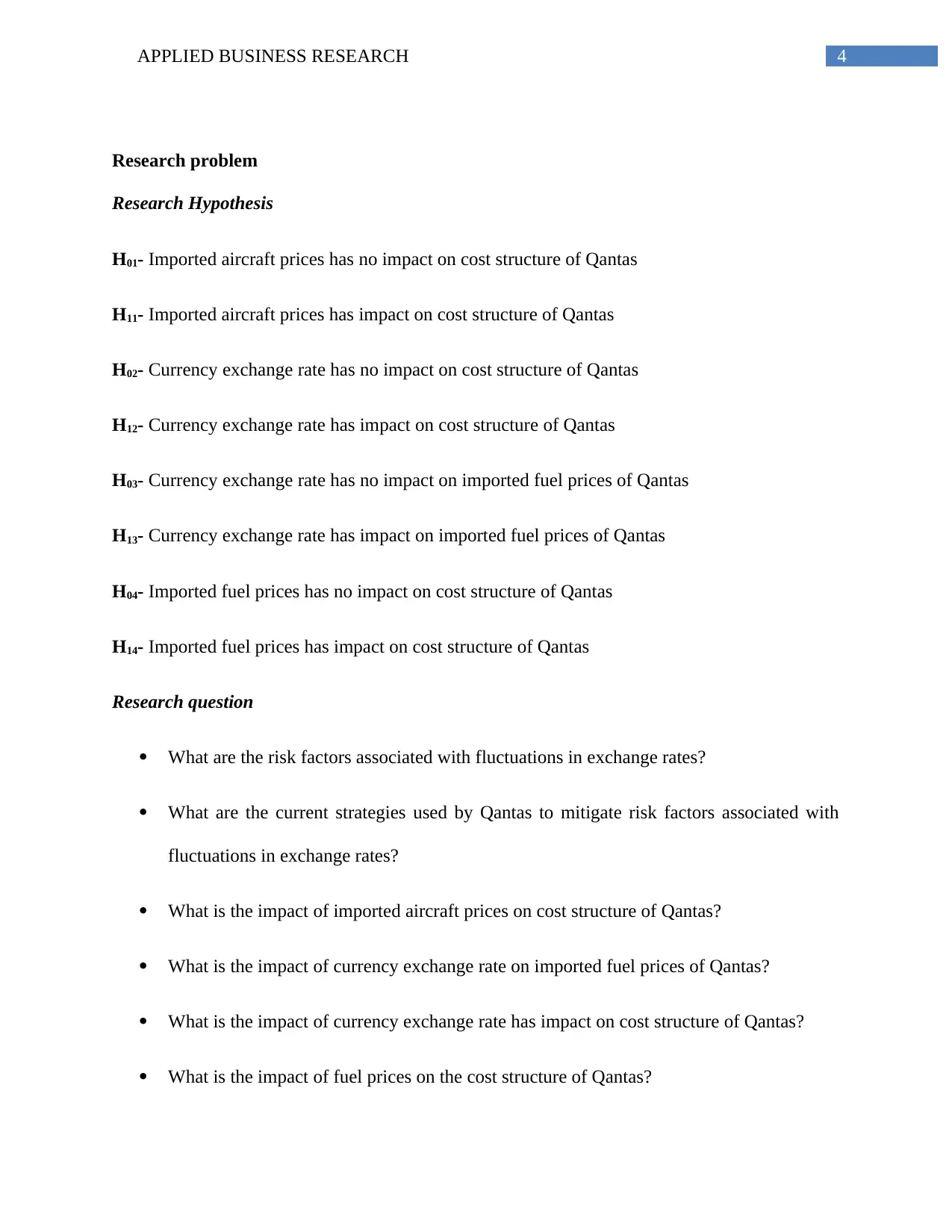
4APPLIED BUSINESS RESEARCH
Research problem
Research Hypothesis
H01- Imported aircraft prices has no impact on cost structure of Qantas
H11- Imported aircraft prices has impact on cost structure of Qantas
H02- Currency exchange rate has no impact on cost structure of Qantas
H12- Currency exchange rate has impact on cost structure of Qantas
H03- Currency exchange rate has no impact on imported fuel prices of Qantas
H13- Currency exchange rate has impact on imported fuel prices of Qantas
H04- Imported fuel prices has no impact on cost structure of Qantas
H14- Imported fuel prices has impact on cost structure of Qantas
Research question
What are the risk factors associated with fluctuations in exchange rates?
What are the current strategies used by Qantas to mitigate risk factors associated with
fluctuations in exchange rates?
What is the impact of imported aircraft prices on cost structure of Qantas?
What is the impact of currency exchange rate on imported fuel prices of Qantas?
What is the impact of currency exchange rate has impact on cost structure of Qantas?
What is the impact of fuel prices on the cost structure of Qantas?
Research problem
Research Hypothesis
H01- Imported aircraft prices has no impact on cost structure of Qantas
H11- Imported aircraft prices has impact on cost structure of Qantas
H02- Currency exchange rate has no impact on cost structure of Qantas
H12- Currency exchange rate has impact on cost structure of Qantas
H03- Currency exchange rate has no impact on imported fuel prices of Qantas
H13- Currency exchange rate has impact on imported fuel prices of Qantas
H04- Imported fuel prices has no impact on cost structure of Qantas
H14- Imported fuel prices has impact on cost structure of Qantas
Research question
What are the risk factors associated with fluctuations in exchange rates?
What are the current strategies used by Qantas to mitigate risk factors associated with
fluctuations in exchange rates?
What is the impact of imported aircraft prices on cost structure of Qantas?
What is the impact of currency exchange rate on imported fuel prices of Qantas?
What is the impact of currency exchange rate has impact on cost structure of Qantas?
What is the impact of fuel prices on the cost structure of Qantas?
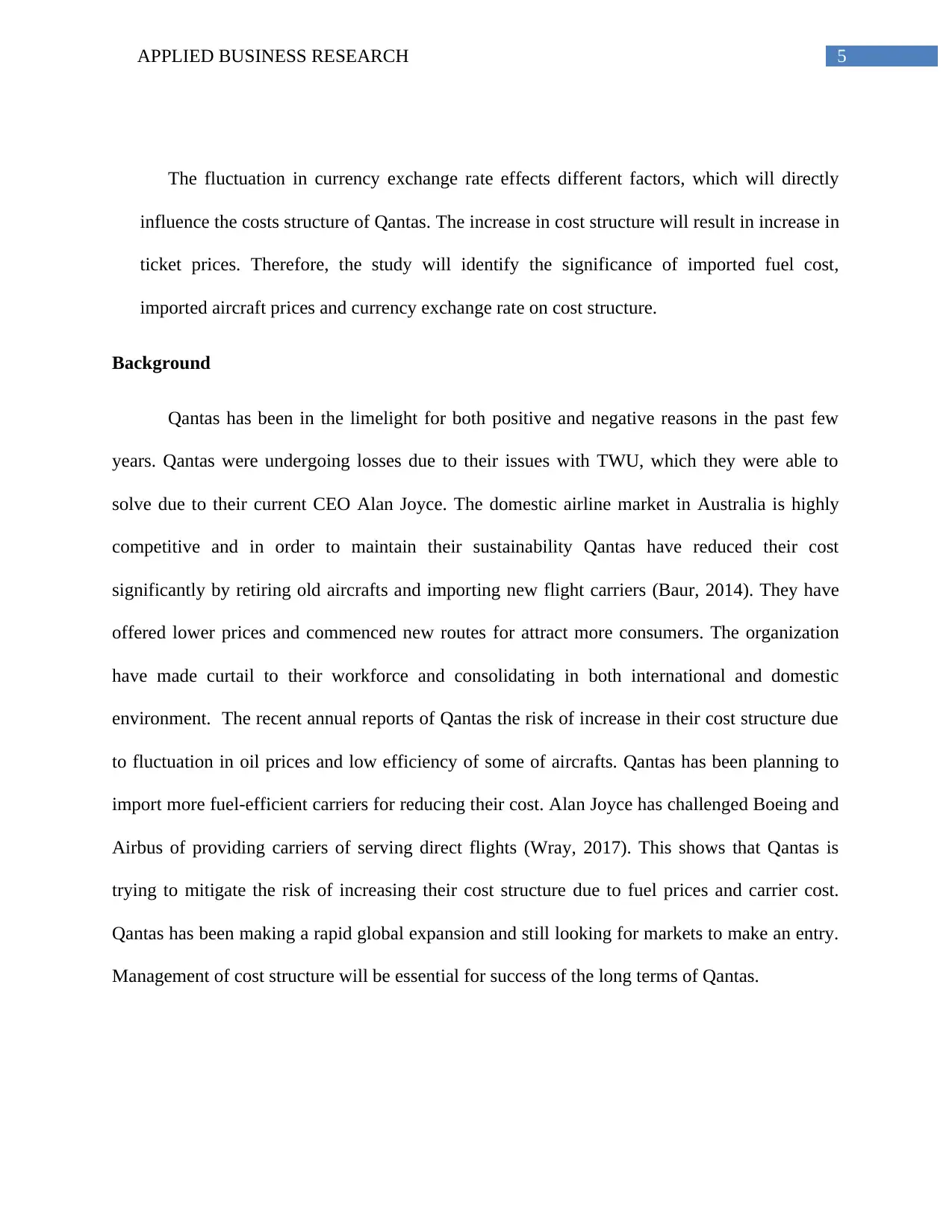
5APPLIED BUSINESS RESEARCH
The fluctuation in currency exchange rate effects different factors, which will directly
influence the costs structure of Qantas. The increase in cost structure will result in increase in
ticket prices. Therefore, the study will identify the significance of imported fuel cost,
imported aircraft prices and currency exchange rate on cost structure.
Background
Qantas has been in the limelight for both positive and negative reasons in the past few
years. Qantas were undergoing losses due to their issues with TWU, which they were able to
solve due to their current CEO Alan Joyce. The domestic airline market in Australia is highly
competitive and in order to maintain their sustainability Qantas have reduced their cost
significantly by retiring old aircrafts and importing new flight carriers (Baur, 2014). They have
offered lower prices and commenced new routes for attract more consumers. The organization
have made curtail to their workforce and consolidating in both international and domestic
environment. The recent annual reports of Qantas the risk of increase in their cost structure due
to fluctuation in oil prices and low efficiency of some of aircrafts. Qantas has been planning to
import more fuel-efficient carriers for reducing their cost. Alan Joyce has challenged Boeing and
Airbus of providing carriers of serving direct flights (Wray, 2017). This shows that Qantas is
trying to mitigate the risk of increasing their cost structure due to fuel prices and carrier cost.
Qantas has been making a rapid global expansion and still looking for markets to make an entry.
Management of cost structure will be essential for success of the long terms of Qantas.
The fluctuation in currency exchange rate effects different factors, which will directly
influence the costs structure of Qantas. The increase in cost structure will result in increase in
ticket prices. Therefore, the study will identify the significance of imported fuel cost,
imported aircraft prices and currency exchange rate on cost structure.
Background
Qantas has been in the limelight for both positive and negative reasons in the past few
years. Qantas were undergoing losses due to their issues with TWU, which they were able to
solve due to their current CEO Alan Joyce. The domestic airline market in Australia is highly
competitive and in order to maintain their sustainability Qantas have reduced their cost
significantly by retiring old aircrafts and importing new flight carriers (Baur, 2014). They have
offered lower prices and commenced new routes for attract more consumers. The organization
have made curtail to their workforce and consolidating in both international and domestic
environment. The recent annual reports of Qantas the risk of increase in their cost structure due
to fluctuation in oil prices and low efficiency of some of aircrafts. Qantas has been planning to
import more fuel-efficient carriers for reducing their cost. Alan Joyce has challenged Boeing and
Airbus of providing carriers of serving direct flights (Wray, 2017). This shows that Qantas is
trying to mitigate the risk of increasing their cost structure due to fuel prices and carrier cost.
Qantas has been making a rapid global expansion and still looking for markets to make an entry.
Management of cost structure will be essential for success of the long terms of Qantas.
⊘ This is a preview!⊘
Do you want full access?
Subscribe today to unlock all pages.

Trusted by 1+ million students worldwide
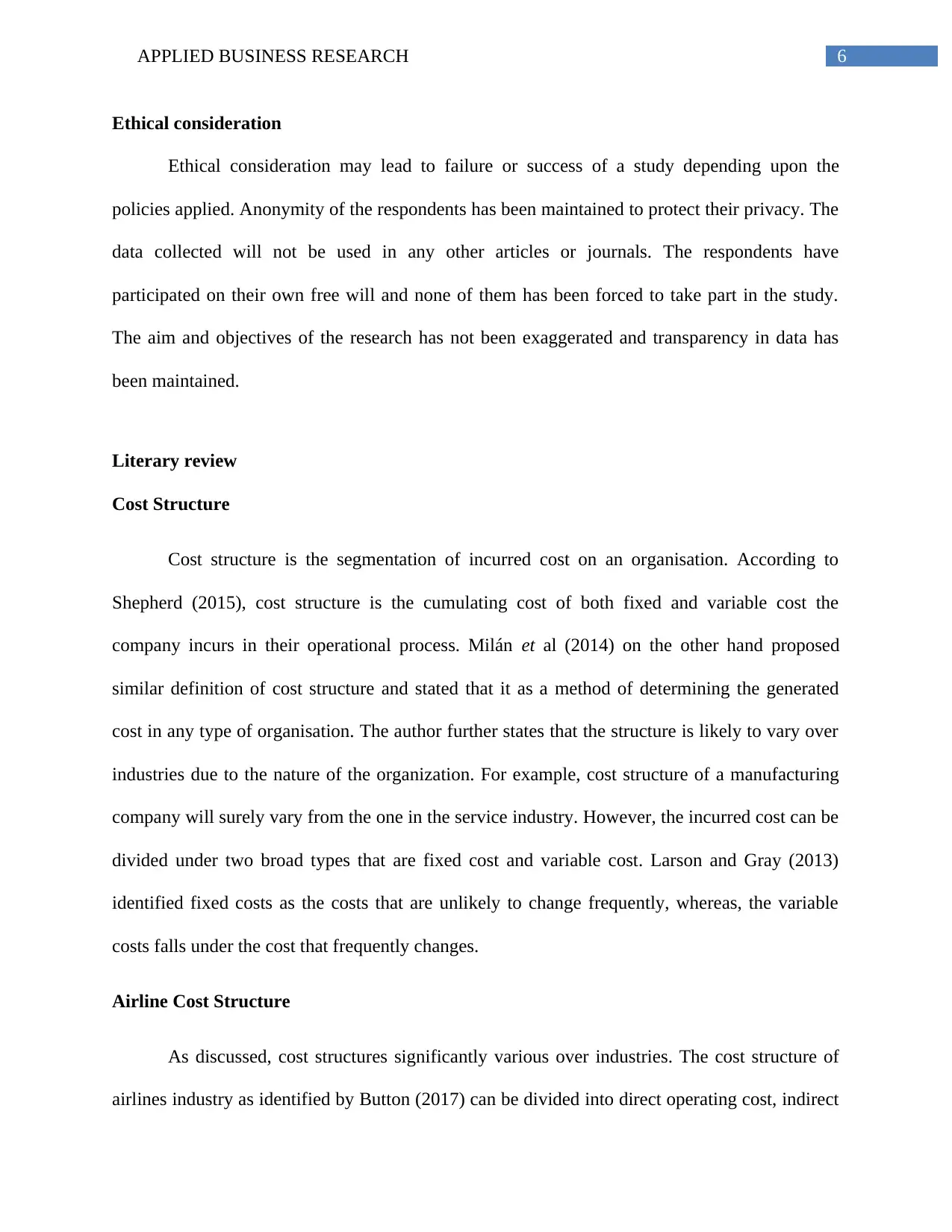
6APPLIED BUSINESS RESEARCH
Ethical consideration
Ethical consideration may lead to failure or success of a study depending upon the
policies applied. Anonymity of the respondents has been maintained to protect their privacy. The
data collected will not be used in any other articles or journals. The respondents have
participated on their own free will and none of them has been forced to take part in the study.
The aim and objectives of the research has not been exaggerated and transparency in data has
been maintained.
Literary review
Cost Structure
Cost structure is the segmentation of incurred cost on an organisation. According to
Shepherd (2015), cost structure is the cumulating cost of both fixed and variable cost the
company incurs in their operational process. Milán et al (2014) on the other hand proposed
similar definition of cost structure and stated that it as a method of determining the generated
cost in any type of organisation. The author further states that the structure is likely to vary over
industries due to the nature of the organization. For example, cost structure of a manufacturing
company will surely vary from the one in the service industry. However, the incurred cost can be
divided under two broad types that are fixed cost and variable cost. Larson and Gray (2013)
identified fixed costs as the costs that are unlikely to change frequently, whereas, the variable
costs falls under the cost that frequently changes.
Airline Cost Structure
As discussed, cost structures significantly various over industries. The cost structure of
airlines industry as identified by Button (2017) can be divided into direct operating cost, indirect
Ethical consideration
Ethical consideration may lead to failure or success of a study depending upon the
policies applied. Anonymity of the respondents has been maintained to protect their privacy. The
data collected will not be used in any other articles or journals. The respondents have
participated on their own free will and none of them has been forced to take part in the study.
The aim and objectives of the research has not been exaggerated and transparency in data has
been maintained.
Literary review
Cost Structure
Cost structure is the segmentation of incurred cost on an organisation. According to
Shepherd (2015), cost structure is the cumulating cost of both fixed and variable cost the
company incurs in their operational process. Milán et al (2014) on the other hand proposed
similar definition of cost structure and stated that it as a method of determining the generated
cost in any type of organisation. The author further states that the structure is likely to vary over
industries due to the nature of the organization. For example, cost structure of a manufacturing
company will surely vary from the one in the service industry. However, the incurred cost can be
divided under two broad types that are fixed cost and variable cost. Larson and Gray (2013)
identified fixed costs as the costs that are unlikely to change frequently, whereas, the variable
costs falls under the cost that frequently changes.
Airline Cost Structure
As discussed, cost structures significantly various over industries. The cost structure of
airlines industry as identified by Button (2017) can be divided into direct operating cost, indirect
Paraphrase This Document
Need a fresh take? Get an instant paraphrase of this document with our AI Paraphraser
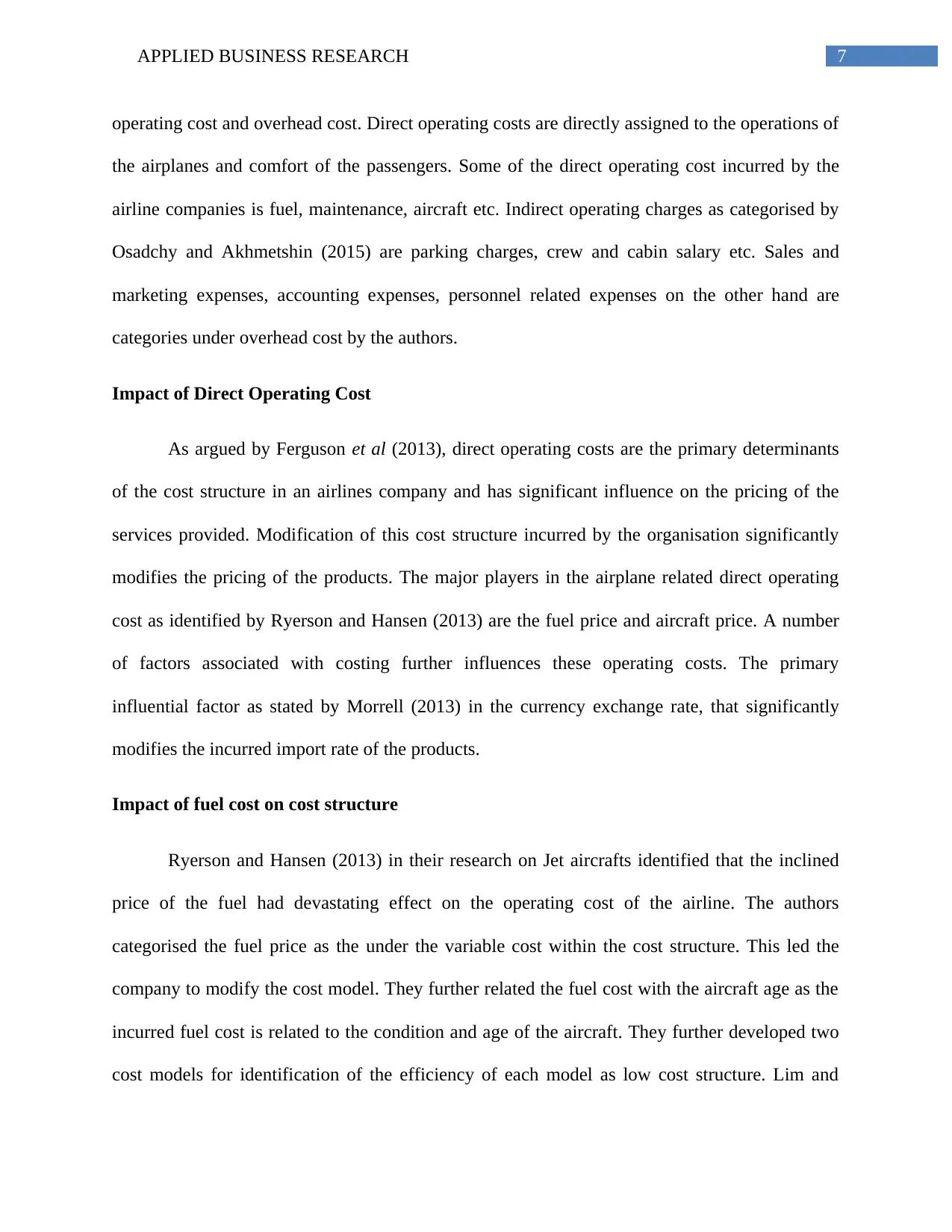
7APPLIED BUSINESS RESEARCH
operating cost and overhead cost. Direct operating costs are directly assigned to the operations of
the airplanes and comfort of the passengers. Some of the direct operating cost incurred by the
airline companies is fuel, maintenance, aircraft etc. Indirect operating charges as categorised by
Osadchy and Akhmetshin (2015) are parking charges, crew and cabin salary etc. Sales and
marketing expenses, accounting expenses, personnel related expenses on the other hand are
categories under overhead cost by the authors.
Impact of Direct Operating Cost
As argued by Ferguson et al (2013), direct operating costs are the primary determinants
of the cost structure in an airlines company and has significant influence on the pricing of the
services provided. Modification of this cost structure incurred by the organisation significantly
modifies the pricing of the products. The major players in the airplane related direct operating
cost as identified by Ryerson and Hansen (2013) are the fuel price and aircraft price. A number
of factors associated with costing further influences these operating costs. The primary
influential factor as stated by Morrell (2013) in the currency exchange rate, that significantly
modifies the incurred import rate of the products.
Impact of fuel cost on cost structure
Ryerson and Hansen (2013) in their research on Jet aircrafts identified that the inclined
price of the fuel had devastating effect on the operating cost of the airline. The authors
categorised the fuel price as the under the variable cost within the cost structure. This led the
company to modify the cost model. They further related the fuel cost with the aircraft age as the
incurred fuel cost is related to the condition and age of the aircraft. They further developed two
cost models for identification of the efficiency of each model as low cost structure. Lim and
operating cost and overhead cost. Direct operating costs are directly assigned to the operations of
the airplanes and comfort of the passengers. Some of the direct operating cost incurred by the
airline companies is fuel, maintenance, aircraft etc. Indirect operating charges as categorised by
Osadchy and Akhmetshin (2015) are parking charges, crew and cabin salary etc. Sales and
marketing expenses, accounting expenses, personnel related expenses on the other hand are
categories under overhead cost by the authors.
Impact of Direct Operating Cost
As argued by Ferguson et al (2013), direct operating costs are the primary determinants
of the cost structure in an airlines company and has significant influence on the pricing of the
services provided. Modification of this cost structure incurred by the organisation significantly
modifies the pricing of the products. The major players in the airplane related direct operating
cost as identified by Ryerson and Hansen (2013) are the fuel price and aircraft price. A number
of factors associated with costing further influences these operating costs. The primary
influential factor as stated by Morrell (2013) in the currency exchange rate, that significantly
modifies the incurred import rate of the products.
Impact of fuel cost on cost structure
Ryerson and Hansen (2013) in their research on Jet aircrafts identified that the inclined
price of the fuel had devastating effect on the operating cost of the airline. The authors
categorised the fuel price as the under the variable cost within the cost structure. This led the
company to modify the cost model. They further related the fuel cost with the aircraft age as the
incurred fuel cost is related to the condition and age of the aircraft. They further developed two
cost models for identification of the efficiency of each model as low cost structure. Lim and
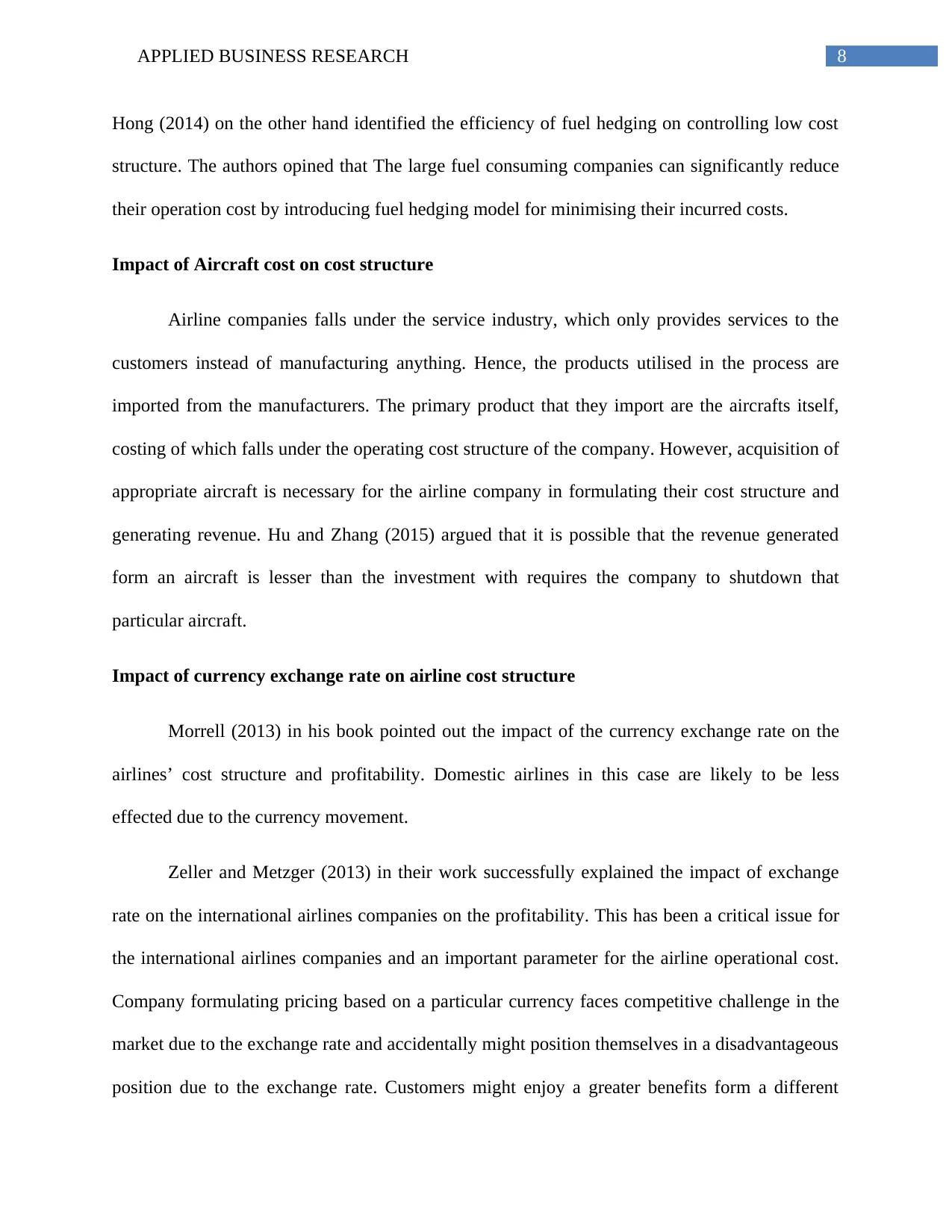
8APPLIED BUSINESS RESEARCH
Hong (2014) on the other hand identified the efficiency of fuel hedging on controlling low cost
structure. The authors opined that The large fuel consuming companies can significantly reduce
their operation cost by introducing fuel hedging model for minimising their incurred costs.
Impact of Aircraft cost on cost structure
Airline companies falls under the service industry, which only provides services to the
customers instead of manufacturing anything. Hence, the products utilised in the process are
imported from the manufacturers. The primary product that they import are the aircrafts itself,
costing of which falls under the operating cost structure of the company. However, acquisition of
appropriate aircraft is necessary for the airline company in formulating their cost structure and
generating revenue. Hu and Zhang (2015) argued that it is possible that the revenue generated
form an aircraft is lesser than the investment with requires the company to shutdown that
particular aircraft.
Impact of currency exchange rate on airline cost structure
Morrell (2013) in his book pointed out the impact of the currency exchange rate on the
airlines’ cost structure and profitability. Domestic airlines in this case are likely to be less
effected due to the currency movement.
Zeller and Metzger (2013) in their work successfully explained the impact of exchange
rate on the international airlines companies on the profitability. This has been a critical issue for
the international airlines companies and an important parameter for the airline operational cost.
Company formulating pricing based on a particular currency faces competitive challenge in the
market due to the exchange rate and accidentally might position themselves in a disadvantageous
position due to the exchange rate. Customers might enjoy a greater benefits form a different
Hong (2014) on the other hand identified the efficiency of fuel hedging on controlling low cost
structure. The authors opined that The large fuel consuming companies can significantly reduce
their operation cost by introducing fuel hedging model for minimising their incurred costs.
Impact of Aircraft cost on cost structure
Airline companies falls under the service industry, which only provides services to the
customers instead of manufacturing anything. Hence, the products utilised in the process are
imported from the manufacturers. The primary product that they import are the aircrafts itself,
costing of which falls under the operating cost structure of the company. However, acquisition of
appropriate aircraft is necessary for the airline company in formulating their cost structure and
generating revenue. Hu and Zhang (2015) argued that it is possible that the revenue generated
form an aircraft is lesser than the investment with requires the company to shutdown that
particular aircraft.
Impact of currency exchange rate on airline cost structure
Morrell (2013) in his book pointed out the impact of the currency exchange rate on the
airlines’ cost structure and profitability. Domestic airlines in this case are likely to be less
effected due to the currency movement.
Zeller and Metzger (2013) in their work successfully explained the impact of exchange
rate on the international airlines companies on the profitability. This has been a critical issue for
the international airlines companies and an important parameter for the airline operational cost.
Company formulating pricing based on a particular currency faces competitive challenge in the
market due to the exchange rate and accidentally might position themselves in a disadvantageous
position due to the exchange rate. Customers might enjoy a greater benefits form a different
⊘ This is a preview!⊘
Do you want full access?
Subscribe today to unlock all pages.

Trusted by 1+ million students worldwide
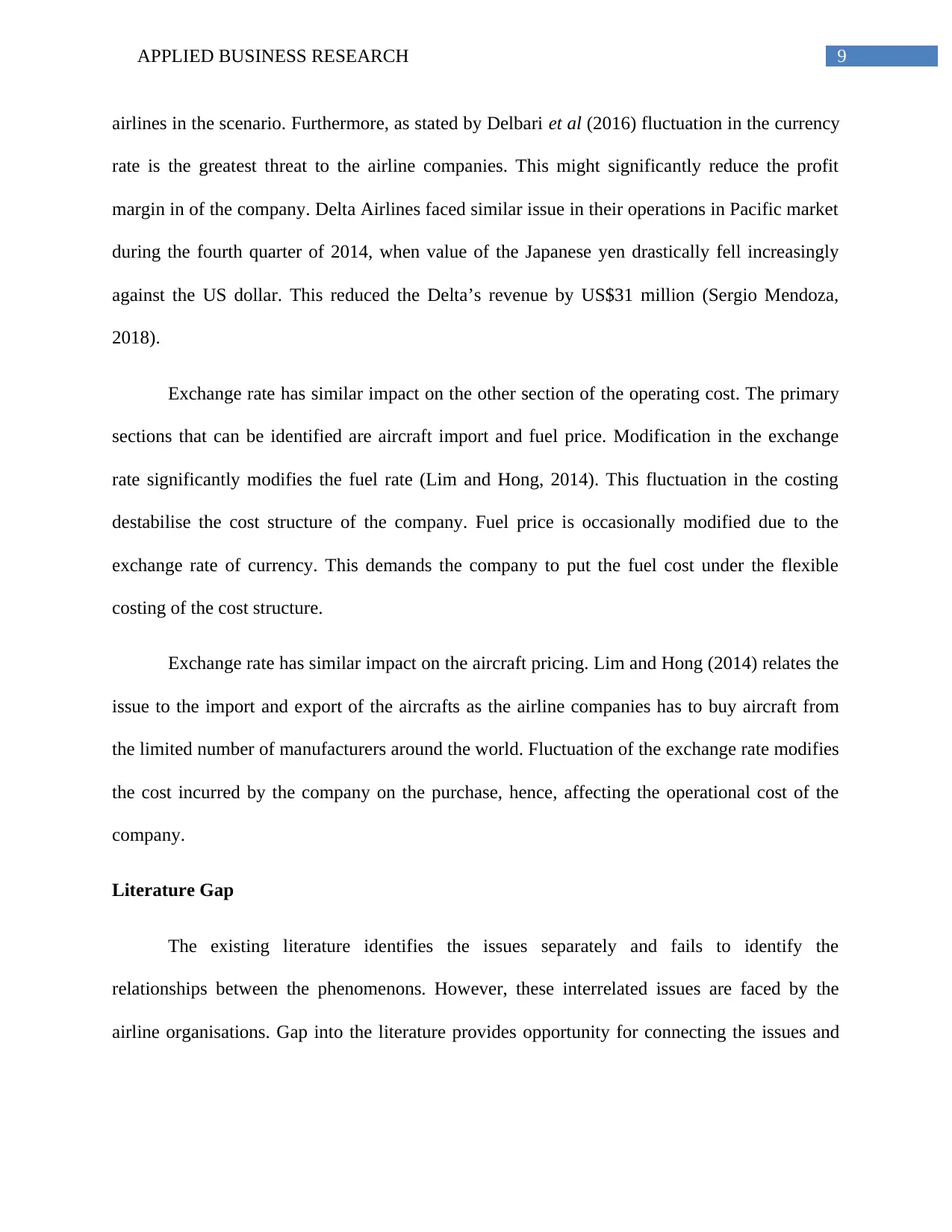
9APPLIED BUSINESS RESEARCH
airlines in the scenario. Furthermore, as stated by Delbari et al (2016) fluctuation in the currency
rate is the greatest threat to the airline companies. This might significantly reduce the profit
margin in of the company. Delta Airlines faced similar issue in their operations in Pacific market
during the fourth quarter of 2014, when value of the Japanese yen drastically fell increasingly
against the US dollar. This reduced the Delta’s revenue by US$31 million (Sergio Mendoza,
2018).
Exchange rate has similar impact on the other section of the operating cost. The primary
sections that can be identified are aircraft import and fuel price. Modification in the exchange
rate significantly modifies the fuel rate (Lim and Hong, 2014). This fluctuation in the costing
destabilise the cost structure of the company. Fuel price is occasionally modified due to the
exchange rate of currency. This demands the company to put the fuel cost under the flexible
costing of the cost structure.
Exchange rate has similar impact on the aircraft pricing. Lim and Hong (2014) relates the
issue to the import and export of the aircrafts as the airline companies has to buy aircraft from
the limited number of manufacturers around the world. Fluctuation of the exchange rate modifies
the cost incurred by the company on the purchase, hence, affecting the operational cost of the
company.
Literature Gap
The existing literature identifies the issues separately and fails to identify the
relationships between the phenomenons. However, these interrelated issues are faced by the
airline organisations. Gap into the literature provides opportunity for connecting the issues and
airlines in the scenario. Furthermore, as stated by Delbari et al (2016) fluctuation in the currency
rate is the greatest threat to the airline companies. This might significantly reduce the profit
margin in of the company. Delta Airlines faced similar issue in their operations in Pacific market
during the fourth quarter of 2014, when value of the Japanese yen drastically fell increasingly
against the US dollar. This reduced the Delta’s revenue by US$31 million (Sergio Mendoza,
2018).
Exchange rate has similar impact on the other section of the operating cost. The primary
sections that can be identified are aircraft import and fuel price. Modification in the exchange
rate significantly modifies the fuel rate (Lim and Hong, 2014). This fluctuation in the costing
destabilise the cost structure of the company. Fuel price is occasionally modified due to the
exchange rate of currency. This demands the company to put the fuel cost under the flexible
costing of the cost structure.
Exchange rate has similar impact on the aircraft pricing. Lim and Hong (2014) relates the
issue to the import and export of the aircrafts as the airline companies has to buy aircraft from
the limited number of manufacturers around the world. Fluctuation of the exchange rate modifies
the cost incurred by the company on the purchase, hence, affecting the operational cost of the
company.
Literature Gap
The existing literature identifies the issues separately and fails to identify the
relationships between the phenomenons. However, these interrelated issues are faced by the
airline organisations. Gap into the literature provides opportunity for connecting the issues and
Paraphrase This Document
Need a fresh take? Get an instant paraphrase of this document with our AI Paraphraser
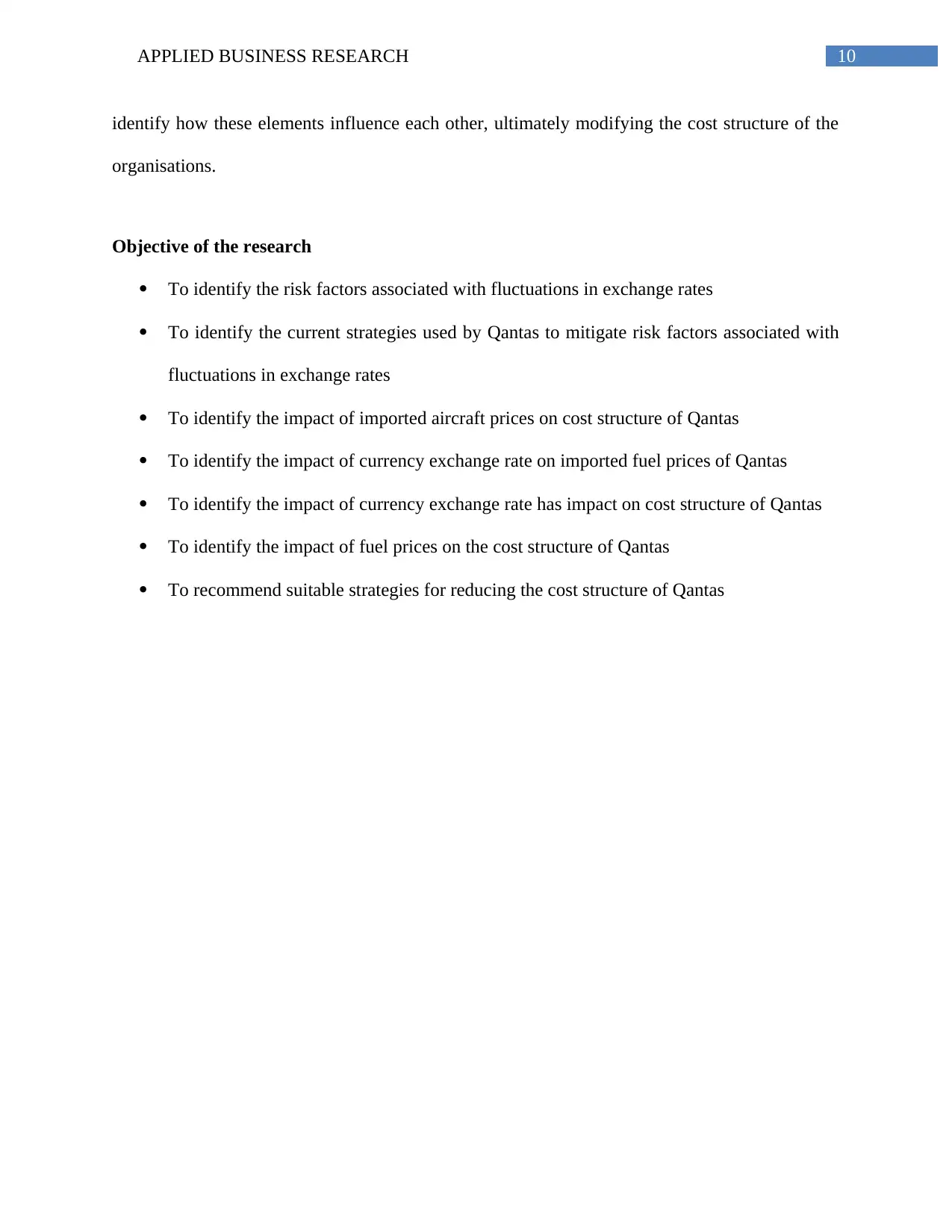
10APPLIED BUSINESS RESEARCH
identify how these elements influence each other, ultimately modifying the cost structure of the
organisations.
Objective of the research
To identify the risk factors associated with fluctuations in exchange rates
To identify the current strategies used by Qantas to mitigate risk factors associated with
fluctuations in exchange rates
To identify the impact of imported aircraft prices on cost structure of Qantas
To identify the impact of currency exchange rate on imported fuel prices of Qantas
To identify the impact of currency exchange rate has impact on cost structure of Qantas
To identify the impact of fuel prices on the cost structure of Qantas
To recommend suitable strategies for reducing the cost structure of Qantas
identify how these elements influence each other, ultimately modifying the cost structure of the
organisations.
Objective of the research
To identify the risk factors associated with fluctuations in exchange rates
To identify the current strategies used by Qantas to mitigate risk factors associated with
fluctuations in exchange rates
To identify the impact of imported aircraft prices on cost structure of Qantas
To identify the impact of currency exchange rate on imported fuel prices of Qantas
To identify the impact of currency exchange rate has impact on cost structure of Qantas
To identify the impact of fuel prices on the cost structure of Qantas
To recommend suitable strategies for reducing the cost structure of Qantas
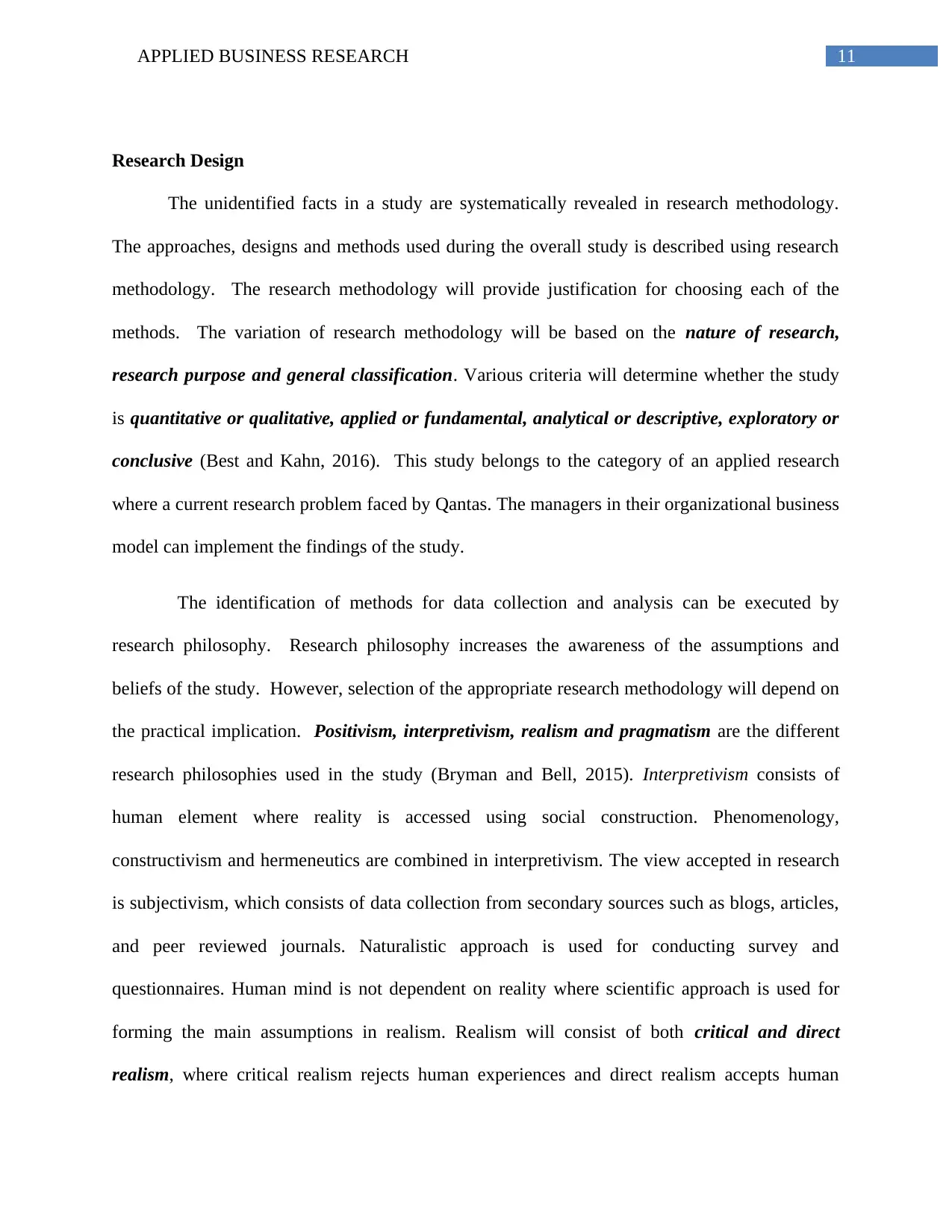
11APPLIED BUSINESS RESEARCH
Research Design
The unidentified facts in a study are systematically revealed in research methodology.
The approaches, designs and methods used during the overall study is described using research
methodology. The research methodology will provide justification for choosing each of the
methods. The variation of research methodology will be based on the nature of research,
research purpose and general classification. Various criteria will determine whether the study
is quantitative or qualitative, applied or fundamental, analytical or descriptive, exploratory or
conclusive (Best and Kahn, 2016). This study belongs to the category of an applied research
where a current research problem faced by Qantas. The managers in their organizational business
model can implement the findings of the study.
The identification of methods for data collection and analysis can be executed by
research philosophy. Research philosophy increases the awareness of the assumptions and
beliefs of the study. However, selection of the appropriate research methodology will depend on
the practical implication. Positivism, interpretivism, realism and pragmatism are the different
research philosophies used in the study (Bryman and Bell, 2015). Interpretivism consists of
human element where reality is accessed using social construction. Phenomenology,
constructivism and hermeneutics are combined in interpretivism. The view accepted in research
is subjectivism, which consists of data collection from secondary sources such as blogs, articles,
and peer reviewed journals. Naturalistic approach is used for conducting survey and
questionnaires. Human mind is not dependent on reality where scientific approach is used for
forming the main assumptions in realism. Realism will consist of both critical and direct
realism, where critical realism rejects human experiences and direct realism accepts human
Research Design
The unidentified facts in a study are systematically revealed in research methodology.
The approaches, designs and methods used during the overall study is described using research
methodology. The research methodology will provide justification for choosing each of the
methods. The variation of research methodology will be based on the nature of research,
research purpose and general classification. Various criteria will determine whether the study
is quantitative or qualitative, applied or fundamental, analytical or descriptive, exploratory or
conclusive (Best and Kahn, 2016). This study belongs to the category of an applied research
where a current research problem faced by Qantas. The managers in their organizational business
model can implement the findings of the study.
The identification of methods for data collection and analysis can be executed by
research philosophy. Research philosophy increases the awareness of the assumptions and
beliefs of the study. However, selection of the appropriate research methodology will depend on
the practical implication. Positivism, interpretivism, realism and pragmatism are the different
research philosophies used in the study (Bryman and Bell, 2015). Interpretivism consists of
human element where reality is accessed using social construction. Phenomenology,
constructivism and hermeneutics are combined in interpretivism. The view accepted in research
is subjectivism, which consists of data collection from secondary sources such as blogs, articles,
and peer reviewed journals. Naturalistic approach is used for conducting survey and
questionnaires. Human mind is not dependent on reality where scientific approach is used for
forming the main assumptions in realism. Realism will consist of both critical and direct
realism, where critical realism rejects human experiences and direct realism accepts human
⊘ This is a preview!⊘
Do you want full access?
Subscribe today to unlock all pages.

Trusted by 1+ million students worldwide
1 out of 18
Related Documents
Your All-in-One AI-Powered Toolkit for Academic Success.
+13062052269
info@desklib.com
Available 24*7 on WhatsApp / Email
![[object Object]](/_next/static/media/star-bottom.7253800d.svg)
Unlock your academic potential
Copyright © 2020–2025 A2Z Services. All Rights Reserved. Developed and managed by ZUCOL.





